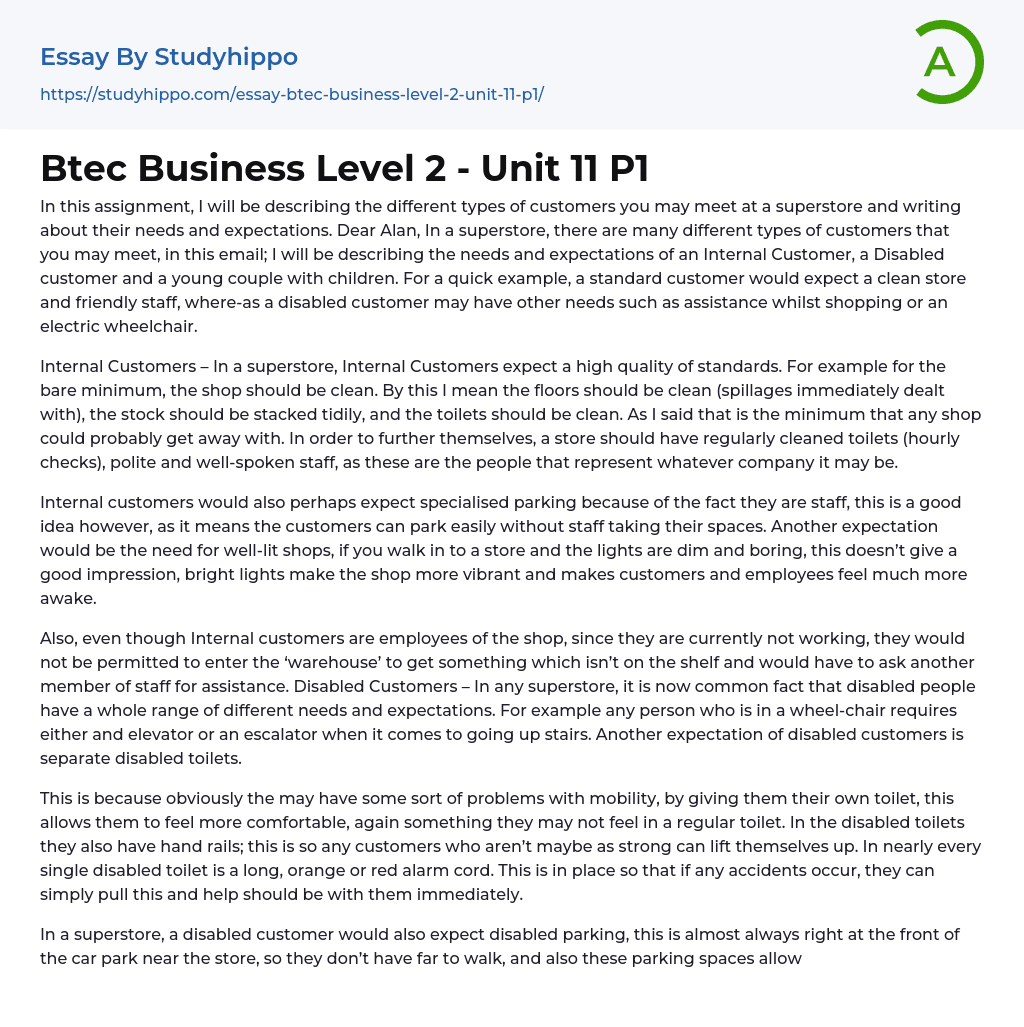In this assignment, I will be describing the different types of customers you may meet at a superstore and writing about their needs and expectations. Dear Alan, In a superstore, there are many different types of customers that you may meet, in this email; I will be describing the needs and expectations of an Internal Customer, a Disabled customer and a young couple with children. For a quick example, a standard customer would expect a clean store and friendly staff, where-as a disabled customer may have other needs such as assistance whilst shopping or an electric wheelchair.
Internal Customers – In a superstore, Internal Customers expect a high quality of standards. For example for the bare minimum, the shop should be clean. By this I mean the floors should be clean (spillages immediately dealt with), the stock should b
...e stacked tidily, and the toilets should be clean. As I said that is the minimum that any shop could probably get away with. In order to further themselves, a store should have regularly cleaned toilets (hourly checks), polite and well-spoken staff, as these are the people that represent whatever company it may be.
Internal customers would also perhaps expect specialised parking because of the fact they are staff, this is a good idea however, as it means the customers can park easily without staff taking their spaces. Another expectation would be the need for well-lit shops, if you walk in to a store and the lights are dim and boring, this doesn’t give a good impression, bright lights make the shop more vibrant and makes customers and employees feel much more awake.
Also, even though Internal customers are employees
of the shop, since they are currently not working, they would not be permitted to enter the ‘warehouse’ to get something which isn’t on the shelf and would have to ask another member of staff for assistance. Disabled Customers – In any superstore, it is now common fact that disabled people have a whole range of different needs and expectations. For example any person who is in a wheel-chair requires either and elevator or an escalator when it comes to going up stairs. Another expectation of disabled customers is separate disabled toilets.
This is because obviously the may have some sort of problems with mobility, by giving them their own toilet, this allows them to feel more comfortable, again something they may not feel in a regular toilet. In the disabled toilets they also have hand rails; this is so any customers who aren’t maybe as strong can lift themselves up. In nearly every single disabled toilet is a long, orange or red alarm cord. This is in place so that if any accidents occur, they can simply pull this and help should be with them immediately.
In a superstore, a disabled customer would also expect disabled parking, this is almost always right at the front of the car park near the store, so they don’t have far to walk, and also these parking spaces allow for extra room for things like getting wheel-chair’s out of the car. Another expectation of some disabled customers is the need for an in-shop assistant. Some customers may be too weak to walk around the shop, or too carry their own bags, so any good superstore should have people on the
ready to help escort these people.
Parent Customers – In a shop, parents have come to expect certain standards. For example, there should be trolleys with adequate seating for young children. Alongside with this there should also be a place for parents to put their pushchairs, so that there not carrying it about whilst pushing the trolley and shopping. Some supermarkets (like the old Safeway’s) have a creche, this is a play-place for children to play in for when their parents are shopping, and this is usually situated upon the entrance.
This is so that parents can shop comfortably without having an annoying, screaming child accompanying them. Another thing parents have come to expect are designated ‘baby changing toilets’, this is so they have the privacy as well as the facilities to change their baby comfortably. Another thing that they could want is someone to help them around the shop, whether this is pushing their trolley, picking up their groceries or simply just packing their bags for them.
It has become common practise for supermarkets to now offer baby-feeding areas; this is so mothers have the option whether to be in private whilst feeding their child. Overall, different customers all have different needs and expectations. For example a standard customer would expect a clean shop, and a warm welcome. A disabled customer would expect specialised parking and toilets and parents would expect trolleys to sit children and designated changing areas. What customers expect depends on their different needs.
- Accounting essays
- Marketing essays
- Automation essays
- Business Cycle essays
- Business Model essays
- Business Operations essays
- Business Software essays
- Corporate Social Responsibility essays
- Infrastructure essays
- Logistics essays
- Manufacturing essays
- Multinational Corporation essays
- Richard Branson essays
- Small Business essays
- Cooperative essays
- Family Business essays
- Human Resource Management essays
- Sales essays
- Market essays
- Online Shopping essays
- Selling essays
- Strategy essays
- Management essays
- Franchising essays
- Quality Assurance essays
- Business Intelligence essays
- Corporation essays
- Stock essays
- Shopping Mall essays
- Harvard Business School essays
- Harvard university essays
- Trade Union essays
- Cooperation essays
- News Media essays
- Waste essays
- Andrew Carnegie essays
- Inventory essays
- Customer Relationship Management essays
- Structure essays
- Starting a Business essays
- Accounts Receivable essays
- Auditor's Report essays
- Balance Sheet essays
- Costs essays
- Financial Audit essays
- International Financial Reporting Standards essays
- Tax essays
- Accountability essays
- Cash essays
- Principal essays




